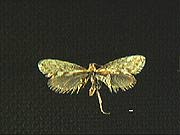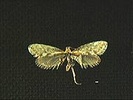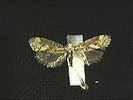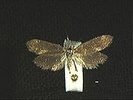Greya obscura
Olle PellmyrAdult Characteristics
Wing expanse 10.5-19 mm. Forewings gray to light brown in the male, dark stramineous or with slight bronzy iridescence in the female, suffused with white ot whitish yellow, forming more or less distinct wing patterning. A rhomboid pale subtornal patch creates an arrowhead when the moth is at rest. Hindwing usually of the same shade as forewing or darker, without pattern.
Comparison with Similar Species
Lightly marked specimens can be mistaken for the sometimes coexisting G. politella. The light subtornal patch is usually present to some degree, even in the weakest of patterned specimens. Definitive identification can be established by checking for a minute pollex in obscura males as opposed to a prominent one in politella, and the absence in obscura of the much elongated seventh abdominal segment in female politella.
Host, Oviposition, and Larval Feeding Habits
The species feeds exclusively on several species of Lithophragma (Saxifragaceae). Eggs are laid in the floral calyx and in stem portion. Larvae do not feed on seeds, and are believed to mine in adjacent vegetative parts.
Geographic Distribution
Ranging from the drier southwesternmost part of Oregon to the San Garbriel Mountains aand southern Sierra Nevada of California.
Habitat
Occurring in grassy portions of open oak woodland, with or without a shrub component. Elevational range 300-1000 m. The species coexists with politella, solenobiella, powelli and suffusca.


Characteristic habitat; Monterey Co., California, USA.
References
Davis, D.R., O. Pellmyr & J.N. Thompson. 1992. Biology and systematics of Greya Busck and Tetragma n. gen. (Lepidoptera: Prodoxidae). Smiths. Contrib. Zool. 524:1-88.
Pellmyr, O., J.N. Thompson, J. Brown & R.G. Harrison. 1996. Evolution of pollination and mutualism in the yucca moth lineage. Amer. Nat. 148:827-847.
Title Illustrations

| Scientific Name | Greya obscura |
|---|---|
| Location | Santa Barbara Co., California, USA |
| Specimen Condition | Dead Specimen |
| Sex | Male |
| Image Use |
 This media file is licensed under the Creative Commons Attribution-NonCommercial License - Version 3.0. This media file is licensed under the Creative Commons Attribution-NonCommercial License - Version 3.0.
|
| Copyright |
© 1996

|
| Scientific Name | Greya obscura |
|---|---|
| Location | Douglas Co., Oregon, USA |
| Specimen Condition | Dead Specimen |
| Sex | Female |
| Image Use |
 This media file is licensed under the Creative Commons Attribution-NonCommercial License - Version 3.0. This media file is licensed under the Creative Commons Attribution-NonCommercial License - Version 3.0.
|
| Copyright |
© 1996

|
| Scientific Name | Greya obscura |
|---|---|
| Location | Josephine Co., Oregon, USA |
| Specimen Condition | Dead Specimen |
| Sex | Female |
| Image Use |
 This media file is licensed under the Creative Commons Attribution-NonCommercial License - Version 3.0. This media file is licensed under the Creative Commons Attribution-NonCommercial License - Version 3.0.
|
| Copyright |
© 1996

|
About This Page

University of Idaho, Moscow, Idaho, USA
Page copyright © 1996
 Page: Tree of Life
Greya obscura .
Authored by
Olle Pellmyr.
The TEXT of this page is licensed under the
Creative Commons Attribution-NonCommercial License - Version 3.0. Note that images and other media
featured on this page are each governed by their own license, and they may or may not be available
for reuse. Click on an image or a media link to access the media data window, which provides the
relevant licensing information. For the general terms and conditions of ToL material reuse and
redistribution, please see the Tree of Life Copyright
Policies.
Page: Tree of Life
Greya obscura .
Authored by
Olle Pellmyr.
The TEXT of this page is licensed under the
Creative Commons Attribution-NonCommercial License - Version 3.0. Note that images and other media
featured on this page are each governed by their own license, and they may or may not be available
for reuse. Click on an image or a media link to access the media data window, which provides the
relevant licensing information. For the general terms and conditions of ToL material reuse and
redistribution, please see the Tree of Life Copyright
Policies.
Citing this page:
Pellmyr, Olle. 1996. Greya obscura . Version 01 January 1996 (under construction). http://tolweb.org/Greya_obscura/12320/1996.01.01 in The Tree of Life Web Project, http://tolweb.org/












 Go to quick links
Go to quick search
Go to navigation for this section of the ToL site
Go to detailed links for the ToL site
Go to quick links
Go to quick search
Go to navigation for this section of the ToL site
Go to detailed links for the ToL site